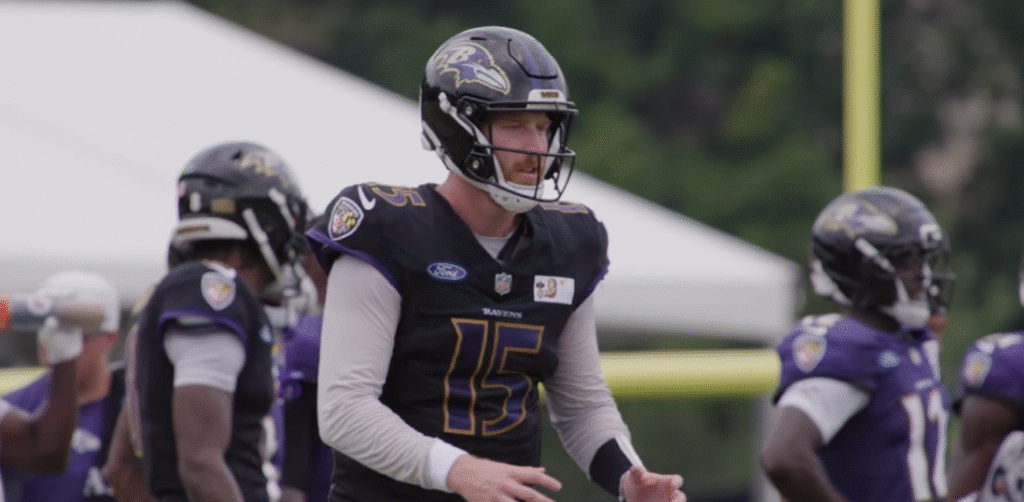The goal of Cooper Rush’s new contract with the Baltimore Ravens, which was revealed in March 2025, was very clear: to support Lamar Jackson with a reliable insurance policy. With incentives that could increase the payout to $12.2 million, the two-year deal has a base value of $6.2 million, highlighting how much NFL teams now value quarterback depth.
After years of service in Dallas, where he established himself as Dak Prescott’s dependable backup, Rush found this deal especially advantageous. During his tenure with the Cowboys, he demonstrated the ability to control chaos and steer the offense without making needless mistakes. His 5-1 record as a starter demonstrated his composure under duress and established him as a reliable hand that is exceptionally useful in dire situations.
Eager to stay competitive, the Ravens recognized the physical risks associated with Jackson’s dynamic play. They made sure that their offense wouldn’t falter in the event that their MVP quarterback suffered an injury by bringing in a seasoned backup like Rush. With a $4 million guaranteed and a $2.7 million signing bonus, this contract was incredibly effective because it was designed to incentivize both performance and availability. Rewards based on playing time demonstrated Baltimore’s confidence in Rush’s ability to perform longer shifts if necessary.
Table: Cooper Rush Bio and Contract Information
| Category | Details |
|---|---|
| Full Name | Cooper Rush |
| Date of Birth | November 21, 1993 |
| Birthplace | Charlotte, Michigan, United States |
| Height | 6 ft 3 in (1.91 m) |
| Weight | 225 lbs (102 kg) |
| Position | Quarterback |
| College | Central Michigan University |
| NFL Entry | Undrafted in 2017, signed by Dallas Cowboys |
| Current Team | Baltimore Ravens (#10) |
| Contract | 2 years, $6.2M base, up to $12.2M with incentives |
| Signing Bonus | $2.7M |
| Guaranteed Money | $4M |
| Previous Team | Dallas Cowboys (2017–2019, 2020–2024) |
| Reference | Cooper Rush on Wikipedia |

Analysts have pointed out in recent days how Rush’s story resembles that of Nick Foles, a backup who became the MVP of the Super Bowl. Although Rush’s expectations are lower, his calm professionalism gives Baltimore security in a league where backup quarterbacks frequently determine playoff outcomes. The Ravens’ choice is in line with a larger NFL trend that values backups as crucial components of championship planning rather than as stand-ins.
Although Rush’s contract is only a small portion of Jackson’s enormous extension in terms of money, the strategic reasoning behind it is incredibly strong. Rush’s salary, which is just over $3 million a year, gives comfort without going over the cap. This contract feels surprisingly affordable in a league where some teams spend a lot of money on marginal talent, which makes it an especially creative move for Baltimore.
Rush’s journey from Central Michigan to signing a multi-million dollar contract after being undrafted is a prime example of perseverance paying off. He assimilated into the Cowboys’ system early in his career and patiently awaited opportunities. When those times came, he made decisions much more quickly than most people anticipated and did so with discipline. Because of his low error rate and incredibly resilient game management abilities, coaches had faith in him.
These days, Baltimore’s quarterback room presents an intriguing tale of contrasts. Rush is the embodiment of cool steadiness, while Jackson, the two-time MVP, is the embodiment of flair and improvisation. The Ravens are able to adjust their tactics based on the situation thanks to this duality. It also gives supporters hope that the season won’t end because of a single injury, which is a significant improvement over prior years when the backup options were unimpressive.
Celebrity comparisons demonstrate how Rush has based his brand on reliability rather than glitz. Rush succeeds as a consistent presence rather than a highlight reel, much like Paul Rudd did when he achieved fame through relatability rather than extremes. Reliability can be extremely versatile in both entertainment and football, guaranteeing opportunities even in the absence of spotlights.
The incentive-heavy contract structure is a reflection of the changing NFL market. As more teams come to terms with the fact that injuries are unavoidable, it makes sense to reward backups for filling in. By working with Rush in this manner, the Ravens crafted an agreement that preserves financial flexibility while encouraging preparedness. This strategy has been especially creative for franchises looking to strike a balance between depth and stars.
The public’s response to the signing was instructive. Dallas supporters reminisced about the serene assurance Rush provided in Prescott’s absence. Supporters of the Ravens applauded the decision as a very effective solution and saw the contract as proof of a front office that values planning. In terms of sports economics, Rush’s contract strikes a balance between undervaluing a role that is too significant to overlook and not going overboard with a star contract.
His signing has cultural significance in addition to numbers. Rush represents the unsung heroes of professional sports—those who streamline processes, practice in private, and only enter the spotlight when called upon. His tenacity serves as motivation for young athletes, demonstrating that consistent dependability can be just as valuable as exceptional skill. That narrative implies that not all professions require fireworks to gain respect and financial stability, and it does so with remarkable effectiveness.
